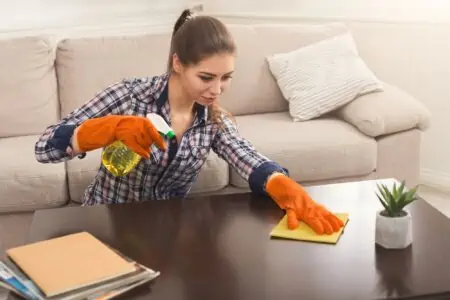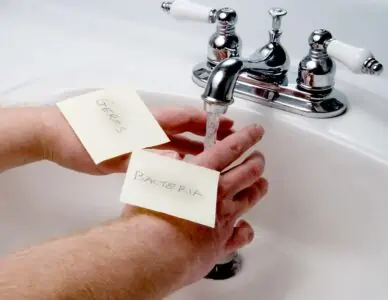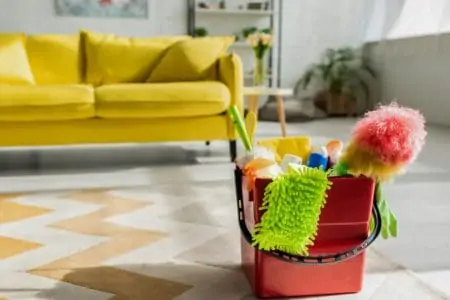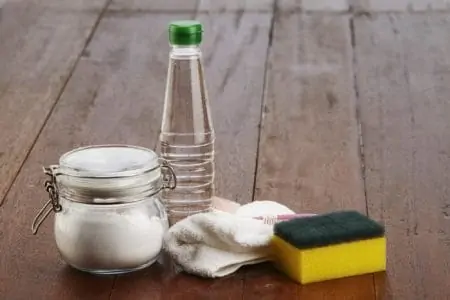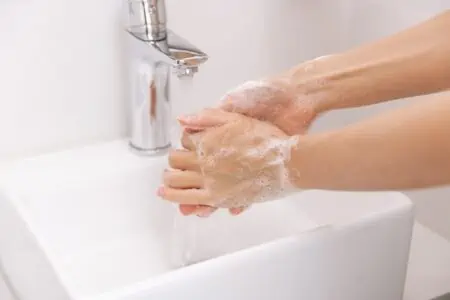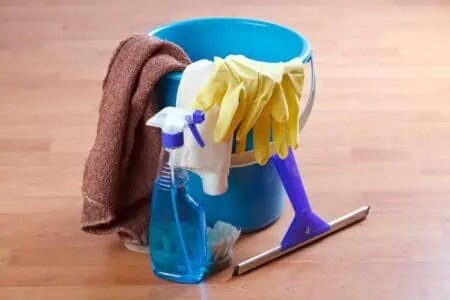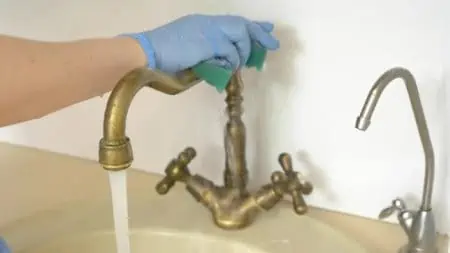Is your wooden furniture looking a little worse for wear? What once was a shiny, flawless statement piece can quickly become an eyesore if you don’t know how to clean wood furniture properly.
Whether you have an old, stained, or dirty piece of wood furniture, you can always do something to restore it. We’ll share how to clean wood furniture, remove sticky and grimy messes, and remove stains.
If your chairs, dresser, coffee table, or other wooden surfaces are gathering dust, scuffs, and stains by the day, stop what you’re doing. Read our tips. And get cleaning.
Key Takeaways
- Dust and clean wooden furniture regularly with a microfiber cloth and mild soap solution.
- For deep cleaning, use a commercial wood cleaner like Murphy Oil Soap.
- Antique wood furniture should be cleaned with gentle products like Old English Lemon Oil.
- Avoid using harsh chemicals, abrasive cleaners, and ammonia-based products on wood furniture.
How to Clean Wood Furniture
One of the most important things to note about cleaning wood furniture is that you should have a routine dusting and cleaning routine. This doesn’t need to take long. Make it part of your weekly cleaning routine, and you’ll stay on top of dirt, scuffs, and stains.
- Time: 20 minutes.
- Difficulty: Easy.
What You’ll Need
- Feather duster.
- Microfiber cloths.
- Dish soap.
- Bowl or container.
- Water.
1. Dust
Using a feather duster or microfiber cloth, dust the wooden piece. You can do this weekly to stay on top of dusty messes. Don’t forget nooks, crannies, ridges, and the furniture’s legs and arms.
2. Wipe With a Cloth
For regular cleaning, all you need is a damp microfiber cloth. Soak it in fresh, clean water and wring it out well before wiping down your wood.
3. Dry Immediately
We don’t want the wood to remain damp, so after wiping it with a wet cloth, follow up with a dry one. Not only will this remove excess moisture, but it will buff up the wood, leaving a nice shine.
4. Tackle Grime
On a weekly basis, you might still find some grease and grime that needs to be removed. For this, mix one teaspoon of dish soap with four pints of water in a bowl or container.
Dip a cloth in the solution. Wring it out well, then wipe the grimy spot. Gently rub in circular motions until the stain or dirt has lifted.
Rinse and dry well with a separate cloth.
How to Deep Clean Wood Furniture
When you skip cleaning for a few weeks, or you’ve just had a party at the house, your wooden furniture can take a beating. But don’t worry — we’ll show you how to clean sticky and grimy messes on your wood furniture.
- Time: 20 minutes.
- Difficulty: Easy.
What You’ll Need
- Wood cleaner.
- Lint-free cloths.
- Container.
- Warm water.
- Measuring cup.
1. Prepare Your Cleaner
We recommend buying a commercial wood cleaner for deep cleaning wood furniture. These are specially designed to remove grease and grime while being kind to your wood. You can avoid completely dehydrating your wood when you use a specialized wood cleaner.
We recommend Murphy Oil Soap because it is 98 percent natural, ammonia- and bleach-free, and works on various surfaces.
Whatever you choose, read the instructions for whether or not it needs to be diluted. In many cases, you must dilute the cleaner in a container with warm water. Use measuring cups for the most accurate ratios.
2. Dust the Wood
Before applying your cleaner, dust the wood using a lint-free microfiber cloth or feather duster.
3. Apply Cleaner
Dampen a lint-free cloth in the cleaning solution and wring it out well. Apply it to the wooden furniture, moving in gentle circular motions. Spend extra time on the sticky, grimy spots.
4. Rinse if Necessary
Many cleaners don’t need to be rinsed off but check the manufacturer’s instructions as to whether the cleaner needs to be rinsed and dried afterward.
How to Clean Old Wood Furniture
You must be a little more careful when cleaning antique or vintage wooden pieces. We’ll show you how to clean this kind of wooden furniture without damaging the surface.
- Time: 20 minutes.
- Difficulty: Easy.
What You’ll Need
- Microfiber cloths.
- Old English Lemon Oil.
- Old sock.
- Grade 0000 steel wool.
1. Dust the Piece
Always start by dusting the wooden furniture. This will remove surface-level debris so that you don’t etch it into the wood during the next steps.
2. Apply Lemon Oil
We’re choosing Old English Lemon Oil because it’s gentle, so it won’t damage the surface of your antique. It will both clean and condition the wood, bringing back its original color and shine.
To apply it, squirt a little onto the wooden piece.
3. Wipe With Your Sock
Once you’ve applied the lemon oil to the furniture, put a sock over your hand and wipe the oil into the furniture. Move with the direction of the grain — avoid circular motions.
We’re opting for a sock because you can feel the direction of the grain as you move. You can also sense any sticky or grimy spots requiring extra elbow grease.
If you don’t have an old sock you can use for this step, using a microfiber lint-free cloth is also great.
4. Remove Stains
If you notice stains, grime, or sticky spots, use your steel wool to lift them gently. Rub the steel wool in the direction of the grain, continuing until you’ve cleaned the unsightly spot. Don’t rub too hard, or you can damage the wood.
What Should You Not Clean Wood With
There are a few products that you should not use to clean wood. These are some items that may cause damage:
- Ammonia.
- Alcohol-based products.
- Household multi-purpose cleaners.
- Undiluted vinegar.
- Alkaline products.
- Abrasive cleaners.
- Steam cleaners.
- Any sandpaper or steel wool higher than #0000.
- Bleach.
How to Clean Stained Wood
Stains are inevitable if you have an oak desk, coffee table, or dining table. Outdoor wooden furniture can also harbor mold and mildew over time. Let’s look at how best to remove three common types of stains.
Water Stains
Dip a paper towel or lint-free cloth into some mayonnaise (yes, you heard us right) and buff the stained area. After a few seconds, the water ring stain will disappear.
You can also try this same trick with olive oil. Leave it on for one hour before buffing away.
Another trick is applying non-gel toothpaste to a lint-free cloth and rubbing the water stain until it lifts. Remove the residue with a damp cloth, then buff the area with a dry cloth.
Ink Marks
For this kind of stain, apply nail polish remover to a cotton ball. Wipe at the ink stain in gentle circular motions — the ink will start to liquefy.
Use a soft, damp cloth soaked with a little more nail polish remover to wipe it off. Continue until all ink residue is gone.
You can also spray hairspray onto the ink stain, but the hairspray must contain alcohol. The alcohol in this will basically erase the ink. Wipe with a soft cloth.
Mold or Mildew
If the furniture isn’t already outside, take it out to prevent mold spores from landing on other pieces inside.
Start by using a bagged vacuum cleaner with a HEPA filter to vacuum the wooden furniture using the soft brush attachment. Afterward, throw the bag away.
Wipe the wooden furniture with a clean, dry cloth.
Make a warm soapy solution in a container. Dip a cloth in the solution, wring well, and wipe the wooden furniture. Rinse the area with a clean, damp cloth.
Let the furniture air dry, and then polish the furniture. You can use a wood polish, such as Howard Feed-N-Wax.
Extra Cleaning Power
If the soapy water solution didn’t kill and remove the mold, try Borax. Make sure you dilute it well — one tablespoon of Borax per cup of water. Apply it to the mold with a soft-bristled brush, scrubbing well to remove the mold. Leave it for one hour before rinsing it with a damp cloth.
How to Repair Cracks and Scratches
You have a few options for fixing cracks and scratches on your favorite wooden piece.
One option is to use a wood restorer to fill in cracks and scratches. Rejuvenate Restorer is a popular option. The formula will fill in scratches and cracks while adding shine to your wooden piece.
Another popular choice is wood filler, such as the Gorilla All Purpose wood filler. As long as you choose the right color, this will provide a filling for cracks, holes, and scratches on your wood furniture.
If these options don’t provide a suitable solution for you, or there are dozens of scratches, call a professional. They will sand down the furniture and fill in dents, scratches, and cracks. They will ensure they use a close-to-perfect color match, and paint, stain, and protect the wood if necessary, too.
Tips For Maintaining Wood Furniture
We want our wooden furniture to stay in the best condition possible. Here are some invaluable tips for caring for wood furniture so that it lasts for generations:
- Use coasters: Protect your wood using coasters, potholders, and tablecloths.
- Avoid heat and light: Keep the wood away from heat sources — fireplaces and radiators — and direct sunlight.
- Polish regularly: Polish your furniture after deep cleaning it. Not only does it provide a nice shine, but finished wood is less likely to become scratched and stained.
- Dust often: Make dusting part of your weekly cleaning routine.
- Use the right cleaners: Don’t use harsh household cleaners. It can damage, strip and discolor your wood.
- Avoid plastic: When plastic materials — such as computers, alarm clocks, and cups — are in contact with the wood for a long time, it can slowly damage the wood.
- Keep pets away: Some pets might love scratching wooden furniture. Train them not to do so, and don’t let them walk across the wood.
- Clean and repair immediately: When you notice stains or scuffs, deal with them immediately.
FAQs
Wonderful Wood
Now that you know how to clean wood tables, chairs, and other furniture items — your wood will feel good as new.
Take time to dust, buff, and remove grime on a weekly basis. A commercial wood cleaner will do the trick when you need to deep clean the wood.
Remember to always use coasters, polish the wood regularly and keep your pets away from your precious pieces.
